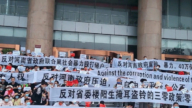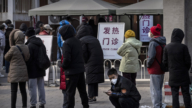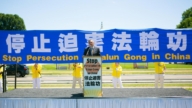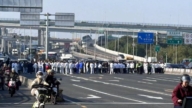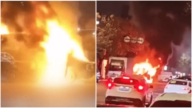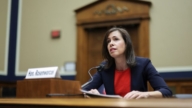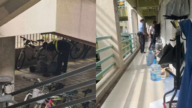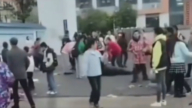【新唐人2011年8月29日讯】“维基解密”最新披露的美国外交电文指出,中共核电计划存在潜在危机,电文警告,中国核电选择廉价、过时的相关技术高速发展,使得中国爆发核子事故的风险大幅增加。请看报导。
日本福岛核电站事故发生后,今年3月中共一度暂停新电站的扩充计划。但不久前,中共当局声称,完成对现有13座核电站的安全检查,对三门电站等在建核电站的检查,预计今年秋季完成。显然,中共的核电站的扩充计划正在野心勃勃的进行当中。
据英国《卫报》8月26号引述“维基解密”最新公布的美国外交电文指出,中国正在建造的22座核电站,有20座采用中国自主设计的CPR-1000 (improved Chinese PWR) 堆型,技术是“廉价,过时”的,而且由于大规模采用,极大增加了核事故的风险。
对于中共当局绕过世界上最先进的由美国研发的AP-1000反应堆,而继续选用以大亚湾核电厂为蓝本的国产反应堆,美国方面表示忧虑,认为这是一个危险的选择。因为按照美国“西屋电器 (Westinghouse)公司”的说法,AP-1000技术比CPR-1000安全100倍,AP-1000 的“被动安全技术”确保在灾难发生的时候,核反应炉会自动关闭。
有关专家指出,没有这一功能的核电站风险很高,被视为缺乏安全性,中国的核反应炉,使用的正是没有“被动安全技术”的CPR-1000,灾难发生时需要依靠人力来控制,困难度高出很多。这使得中国所有核电厂的综合风险正大幅增加,中共当局也承认,它不如新型号安全。
另一封美国外交电文指出,中国培训核电人才的速度,追不上核电的高速发展,大大增加核事故风险,担心会成为高铁事故的翻版。
电文还披露,中国“所有核反应炉的购买,至今大多是高层内部的政治决定,缺乏任何公开程序”。 电文还指出,中国核电厂招标过程不透明、政府游说施加影响,以及,与中国快速扩充的核子部门管理与规范监督存在问题。
美国“哈佛大学”中国核计划专家周赟说,日本福岛核事故发生后,中国罕见的暂停新核电专案,这显示出专案安全当初缺乏审慎的评估。
中国计划在2020年前建成50到60座新的核电厂,其中36座,计划未来十年中建成。
8月26号,位于深圳大亚湾核电基地的“广东岭澳核电站”二期全面建成投产。大亚湾核电站,是中国第二座核电站。上世纪80年代,大亚湾核电站筹建之初,上百万香港民众曾签名反对。
大亚湾核电站建成后曾多次发生核泄漏事故。仅去年(2010年)一年就有三次事故。2010年5月23号,核幅射泄漏超出厂区范围,严重威胁附近居民性命安全。据报导,发生泄漏的元件是最内层的核保护层燃料棒,原先一直使用法国出产的燃料棒,三年前开始转用大陆制的军用燃料棒。
去年(2010年)10月23号,冷却反应堆的喉管发现三条裂纹,并渗漏出带有辐射的硼结晶,相当于照20次X光的剂量。这次泄漏事故事件按照国际核事件分级表属于第一级的异常事件,但核电厂泄露事故直到一个月后才被媒体披露,民众因此质疑核电站有意隐瞒。
《前哨》杂志总编辑刘达文指出,大亚湾核电站经常隐瞒事故、不受监管,当中涉及中共官商勾结,直接触及控制着中国电力系统的李鹏家族。
新唐人记者许旻、李若琳综合报导。
China’s Nuclear Reactors a Risk
A latest U.S. diplomatic cable released by WikiLeaks reveals
that China’s nuclear power program poses a potential risk.
It warns that China’s authorities opt for cheap and outdated
technologies for its nuclear expansion.
This vastly increases the risk of nuclear accidents.
After Japan’s Fukushima Nuclear Accident in March 2011,
the Chinese Communist Party (CCP)
temporarily halted its nuclear expansion program.
Not long ago, the CCP authorities announced that the 13
existing nuclear plants passed official safety inspections.
Checks for the facilities under construction such as the
Sanmen Nuclear Plant would be finished by October.
The CCP’s nuclear expansion is apparently well under way.
On August 26, the Guardian reported that 20 of 22 nuclear
plants under construction used cheap CPR-1000 reactors.
This has “vastly increased" the risk of a nuclear accidents,
according to a U.S. diplomatic cable.
The U.S. is concerned that the CCP authorities
bypassed the state-of-the-art AP1000 reactor
developed by the U.S. company Westinghouse.
China continues to use domestically produced reactors
supplied by Daya Bay (Daya Wan) Nuclear Plant.
This was a dangerous choice.
According to Westinghouse, AP-1000 is 100 times safer
than CPR-1000. Because in the event of a disaster,
AP-1000’s Passive Safety Technology ensures that
a reactor will automatically shut down.
Experts point out that without this feature,
a nuclear plant is considered highly risky.
The CPR-1000 employed by China’s nuclear plants
is without the :Passive Safety Technology.”
In the event of a disaster, the plant would rely on human
intervention – difficult to provide during a crisis situation.
This vastly increases the combined risk
of China’s existing nuclear plants.
The CCP authorities also acknowledged
that CPR-1000 is less safe than the newer models.
WikiLeaks revealed that the speed China’s nuclear
expansion is faster than the training speed of the personnel.
This greatly increases the risk of nuclear accidents, and
the nuclear plants may end up to be like high-speed trains.
According to WikiLeaks, the purchases of China’s reactors
to date have been decided internally by high level officials.
absent of an open process."
The document highlights the secrecy of the opaque
bidding process for power plant contracts, the CCP authorities’
influence and potential weaknesses in the management
and regulatory oversight of fast-expanding nuclear sector.
Zhou Yun, nuclear expert at Harvard University,
said that in the wake of Fukushima Nuclear Accident,
the CCP authorities suspended the permits for new plants.
This showed that it lacked careful initial safety assessment
on the nuclear power projects.
The CCP authorities plan to build 50-60 new nuclear plants
by 2020. 36 of them will be completed in the next 10 years.
On August 26, Daya Bay Nuclear Power Station’s
Guangdong Ling Ao Nuclear Power station second phase
was put into operation.
The Daya Bay plant is China’s second nuclear power station.
In the 1980s, during its Preparation & Construction Phase,
a million Hong Kong citizens signed a petition opposing it.
After operation started, the Daya Bay Nuclear Plant
experienced several radioactive leakages.
In 2010 alone, leakage accidents occurred three times.
On May 23, 2010, the leakage-affected range was beyond
the plant premises, threatening the nearby residents.
It was reported that radioactive leakage came from
the innermost fuel rods.
The fuel rods were previously imported from France,
but 3 years ago, the plant started to use domestic ones.
On October 23, 2010, three cracks were found on the
cooling pipelines of the reactor,
long with the leakage of radioactive boron crystals,
equivalent to 20 chest X-rays.
The event was assessed as Level 1
on the International Nuclear Event Scale,
This was not reported until a month later. This aroused the
public’s doubt of an authorities’ intentional cover-up.
Lau Tat Man, ex Editor-in-Chief of Outpost Magazine, said
that the Daya Bay Nuclear Plant often conceals accidents.
Behind all this are the collusions between CCP officials
and businessmen.
This is directly linked to ex-CCP premier Li Peng’s family,
who controls China’s electrical power system.
NTD reporters Xu Min and Li Ruolin


